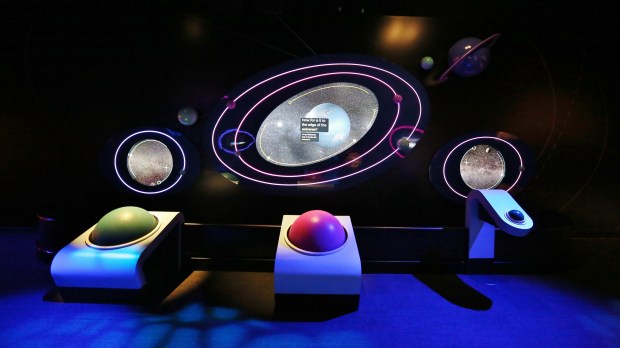Space is no longer the final frontier at The Franklin Institute.
In a total re-imagining of one of the more popular exhibits in Philadelphia’s science museum, the $85 million “Wondrous Space” is now open.
“I’m so excited that there are now astronomy related exhibits on all four floors (of The Franklin Institute),” said Derrick Pitts, the museum’s chief astronomer. “As the universal fascination with space continues, and we can see this in all of the news that we see around today, of the many different kinds of technologies and launches and space exploration missions that are happening even as we speak, ‘Wondrous Space’ will be at the forefront, inspiring the next generation of astronomers, engineers and space travelers.”
“Wondrous Space” spans two floors of The Franklin Institute. Meanwhile, the Fels Planitarium and refurbished Holt and Miller Observatory on the fourth floor puts outer space firmly in the museum’s footprint.
“The Franklin Institute is a world-renowned science museum that has been inspiring curiosity and creativity for 200 years,” said Larry Dubinski, president and CEO of The Franklin Institute. “With the launch of ‘Wondrous Space’ and the exhibits to follow, we are poised to enter an exciting new era of innovation and discovery and continue our mission of inspiring the next generation of scientists, engineers and explorers.”
Built in conjunction with actual rocket scientists from Boeing and a $3 million gift from the company, “Wondrous Space” can best be described as a mini Smithsonian Air and Space Museum. There are space artifacts, including a piece of an actual meteorite, and virtually everything is interactive, the institute said.
“This museum means so much to me, because it impacts the students of this area in outstanding ways,” said Amanda Ireland, Boeing’s CST-100 Starliner Mission Integration & Launch Operations engineer. “When I was a student in elementary school, middle school, I didn’t quite see myself in space yet.”
Ireland grew up in Montgomery County, attended high school at Methacton and then graduated from Drexel University. Similar to many students around the region, The Franklin Institute was a yearly school trip for her.
“We’re trying to show students that they belong in this industry,” Ireland said. “We’re inviting them into incorporating work in science. More than just getting ready for their classes, but also to see themselves long term. So we’re really excited about that.”
“Wondrous Space” takes over the previous “Changing Earth” area. Gone are the weather forecasts and rain maps. In its place, a visitor can guide a rover around the surface of Mars, the institute said.
The first level fully immerses guests in simulations and experiences that will “transport” them to space, allowing them to control the forces of nature, travel immeasurable distances across the universe, and witness awe-inspiring space phenomena.
The upper level takes on a completely distinctive design tone, delving into space through the lens of creativity and innovation, providing a deeper understanding of the future of life and work in space, showcasing new tools, tech and techniques, as well as rising industry leaders and the varying careers related to space exploration and discovery, the institute said.
“This is not a space exhibit in which it’s like an amusement park, where you try to promise some experience that can’t be had in a 1G environment.” Pitts said. “What we do is we connect people through these full body experiences and multi-person experiences to be able to get closer to what it means to understand how the universe works.”
Speaking of amusement parks, The Franklin Institute also partnered with MDSX, which specializes in physical and digital design, including scenic design, motion graphic design and interactive design for themed entertainment, museums, resorts and branded environments.
“We wanted to create an immersive journey that not only showcases the wonders of space, but also takes you on a voyage to feel the awe and wonder of space exploration itself,” said MSDX co-owner and creative director Dan Picard. “What makes this exhibit truly unique is the two distinct designs. We aim to share not only the joy of space exploration, but also the importance of space in everyday life. Space isn’t just for astronauts. It requires diversity of talents from designers, cooks, artists, and even business development. Space needs everyone, and our exhibit aims to convey that message in a captivating way.”
“Wondrous Space” is not a special exhibit so it’s part of the normal day at The Franklin Institute. Check out https://www.fi.edu for more information.




